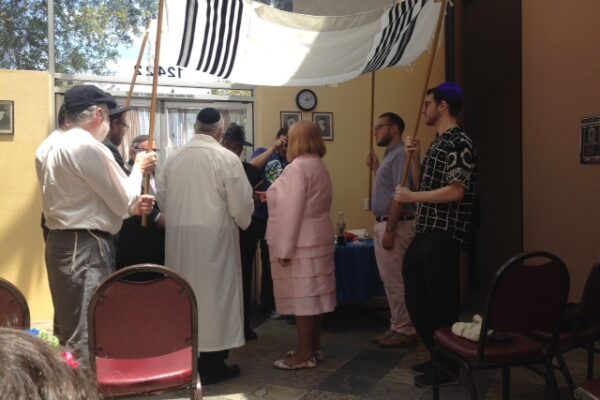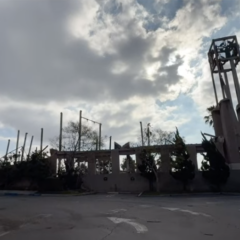By Asher Levy and Jonathan Kaye
The North Hollywood Orthodox Jewish community is a substantial, thriving community with kosher markets and restaurants, synagogues, schools and all of the accouterments of observant Jewish life. This summer, we’ve been part of a team of interns at CRCC mapping religious congregations in various parts of Los Angeles. For the Valley portion of the mapping project, we chose to explore this Jewish neighborhood because we grew up in it and have a working knowledge of Hebrew, Jewish liturgy and religious customs.
Most importantly, as Jewish day-school graduates who have made the transition into academic research, we wanted to investigate the insider/outsider dichotomy inherent in the study of religion. We had already experienced being outsiders mapping congregations around the cities, and wanted to attempt the same research in a more familiar setting, to get a better sense for the differences between the study of one’s roots and the study of other communities.
Bais Midrash Toras Hashem is a vital center of Jewish life and learning in the North Hollywood Orthodox community, offering ample opportunities for learning, prayer and celebration. It was here where we had our most fascinating, memorable mapping experience, our participation in which straddled the boundaries of insider and outsider.
When Asher entered the building (while Jonathan was parking), the outgoing and gregarious Rabbi Zvi Bloch greeted him enthusiastically, asking him if he was Jewish. Bloch, who has led the synagogue for 33 years, is known for his enthusiastic Jewish outreach, as well as his work with converts to Judaism.
When Asher answered in the affirmative, Bloch asked him if he was really Jewish. At that point Asher knew something was up, and that his services as a member of the tribe would be required in some form or another.
Bloch then asked if he had a half hour; he had a dilemma, which Asher could help solve. A couple, about to be married in a small ceremony at the synagogue, lacked the minyan, or ritual prayer quorum of ten Jewish men (or men or women in liberal Judaism), necessary for the ceremony to be legally binding in the eyes of Jewish law. Would Asher, Bloch inquired, be able to make the minyan so that the wedding could commence? Asher responded that he could do him one better: Jonathan was coming in shortly and he was Jewish too.
“Perfect!” Bloch gleefully responded. “We have a minyan!”
We joined the rest of the minyan at a long table in the main prayer and study space of the synagogue. Cookies and schnapps were present on the table, as was the ketubbah, the Jewish marriage contract. We soon learned that the bride-to-be had finished her conversion to Judaism days before; the rabbinical court of three rabbis that had presided over her conversion were present, including Rabbi David Adatto, a family friend of Asher’s and the leader of Sha’arei Yerushalayim Congregation, a synagogue located across the street from Bais Midrash, where Asher had spent many a Shabbat with his family.
Once seated around the table, we told Adatto that we were there doing research for the mapping project. Upon hearing this, he expressed enthusiasm for the project and was intrigued by how his congregation could benefit from the community services that the mapping project brings to light. This was the first time during our work for CRCC that a religious leader inquired about how they could benefit from the research. We had encountered negativity and indifference in the past, but never outright enthusiasm, which was refreshing, as was the first-hand knowledge that our work can benefit the communities that we visit.
The groom, dressed in a kittle, a white Jewish shroud-like robe worn on auspicious occasions, entered the room; he was followed by his surprisingly blank-faced, stoic bride-to-be, who was dressed in a boxy, frilly, pink suit.
During the exchange of rings, Rabbi Bloch asked the groom if he was prepared to enter into the bonds of matrimony in the sacred tradition of Moses and the people of Israel; he said he was. Bloch asked the bride if she was prepared to enter into the covenant of marriage with her groom; she answered, in a gravely serious voice, “If he remains a pious, righteous and upright man of the Lord.” The rabbis were taken aback by the severe piety of her answer, as were we!
Next, as the formal ceremony commenced, we were given the honor of holding up the chuppah over the couple and Bloch. The chuppah is a ceremonial wedding canopy, in this case made of a tallit, the fringed shawl worn during Jewish prayer, suspended by four poles, symbolizing the home that the couple will build together, as well as the presence of God.
It was a humbling experience to make possible, let alone participate in, one of the most important milestones in the lives of two individuals, as well as to bear witness to one of the most sacred, intimate and holy Jewish rituals.
After the ritual breaking of a glass, which symbolizes the destruction of the Temple in Jerusalem as well as the brokenness of the world, we joined the community in frailech simcha song and hora dance around the surprisingly stoic, freshly converted bride. We then proceeded to the social hall, along with the rest of our motley minyan, for a nosh of pickled herring (a specialty in the world of yeshivas, institutions of Jewish learning with a particular emphasis on Talmud and legal texts), shots of schnapps, and bagels with shmear and lox. It was a casual and pleasant reception, one in which we were happy to take part.
A young yeshiva student sitting across from us, who had also been roped in to complete the minyan, exhibited tremendous chutzpah as he loudly answered his phone during the reception: “I’m here at the convert bride’s wedding. There’s some nosh, it’s ehhhh, not bad.” While shouting into his cellphone, this chutzpadik shnorrer (nervy freeloader) then sliced himself a fat slab of the “convert bride’s” personal challah and thickly shmeared it with a generous mound of cream cheese. If the bride cared, she didn’t it show it.
The bride’s stoicism was in keeping with the legalistic mood of the day; despite the dancing and smoked fish, it was clear that the purpose of the wedding was to validate the couple’s previously secular union in the eyes of Jewish law following the bride’s conversion.
If she was mostly unmoved, we, on the other hand, were caught up in the wonder of the experience; walking into a house of worship with the intention of conducting research from an outsider perspective, we were swept up in the life of the community and afforded intimate, insider privilege at this momentous occasion.




